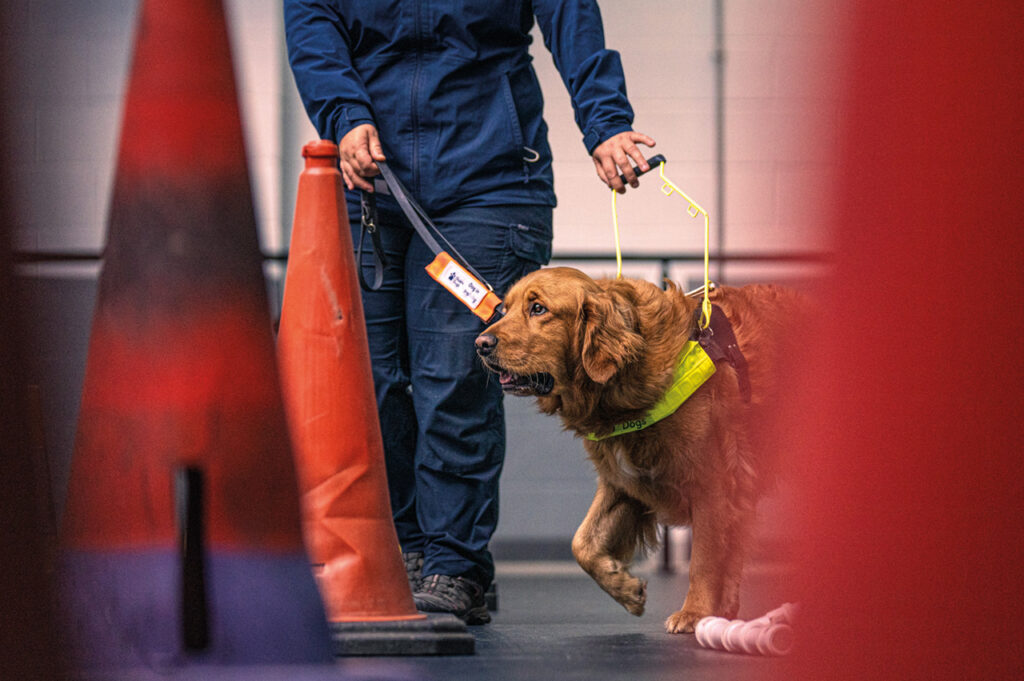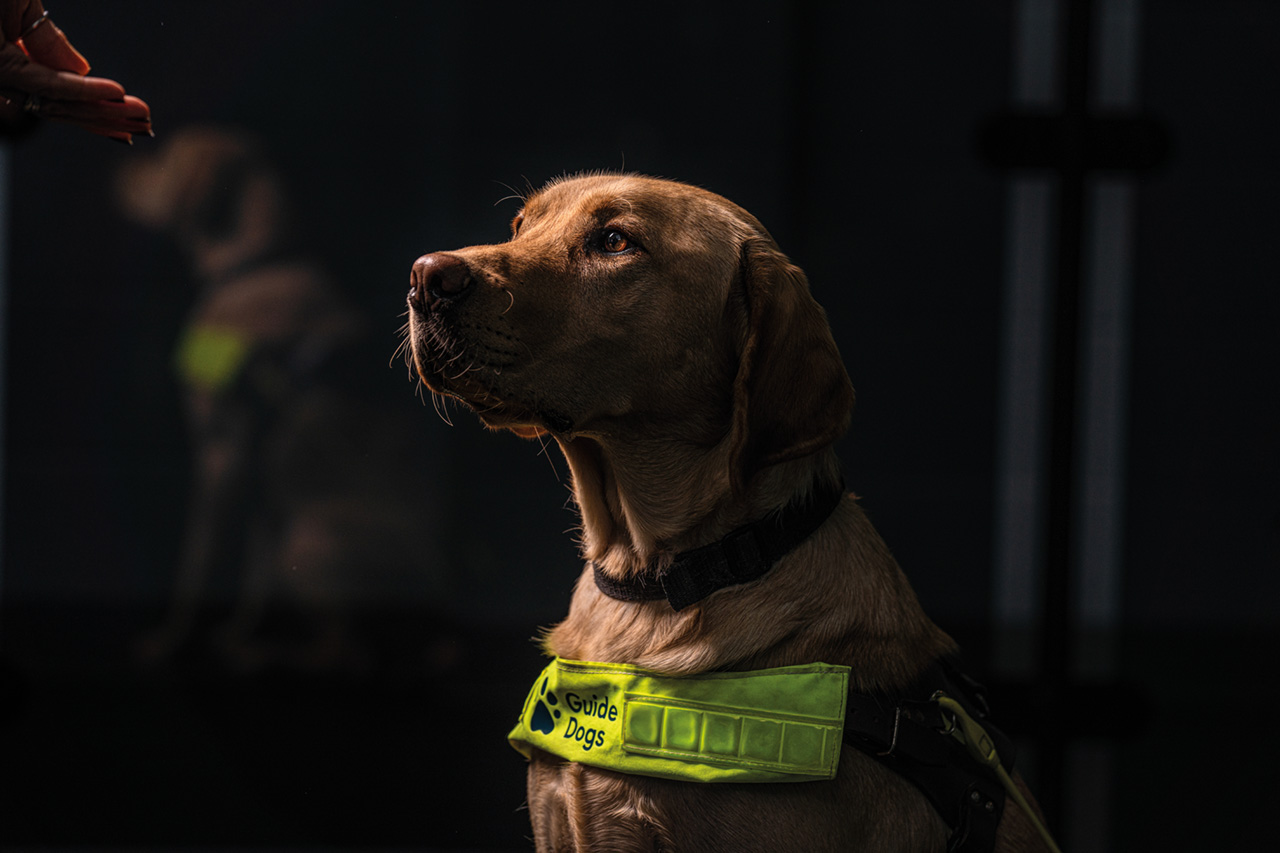A guiding light
It’s as scary now to be told you’re losing your sight as it was 90 years ago. What’s changed though is that a guide dog may make life much easier. And it’s all down to two remarkable women
Ninety years ago, in a garage in Wallasey, Merseyside, two pioneers were hard at work. Muriel Crooke and Rosamund Bond, both German shepherd breeders, were teaching four of their dogs to identify and avoid obstacles, find doors and safely cross a road.
The pair had read about ground-breaking projects overseas that were working to train dogs to become assistance animals for injured First World War veterans, and they were determined to master the art themselves.
“Muriel and Rosamund had heard about assistance dog programmes in other countries and decided to give it a go.”
Inspired by work in the US, Germany and Switzerland, Crooke and Bond enlisted four German shepherds – Flash, Folly, Meta and Judy – and developed a training programme designed to teach the dogs the necessary commands to give injured soldiers a new lease of life.
After the First World War, thousands of soldiers returned from the front blinded, often by poison gas. Others were left with lifelong disabilities including lost limbs and extensive burns.
Just a few months after Crooke and Bond handed over their first guide dogs, four ex-servicemen’s lives had been transformed. They reported a new sense of freedom and independence they had not known since before the war.
It was then that the charity Guide Dogs was born. Since 1931 the charity has evolved from its humble beginnings into an organisation that strives to empower the blind and visually impaired to live independent lives. There have been 36,000 guide dog partnerships since its inception, and the charity boasts a world renowned breeding and training programme.
“Muriel and Rosamund’s work with ex-servicemen really resonates with people today,” says Guide Dogs’ regional marketing and communications manager Shirley Morgan. “That’s what Guide Dogs is all about. It’s about giving blind and visually impaired people the ability to live the life they choose. It is such a lovely story. And it all started here in the North West.
“I hope that Muriel and Rosamund would feel proud. And I think they would really appreciate the way the charity has evolved over the last 90 years.
“The essence of what they did is still in every dog that’s trained. But the things at our disposal now are probably things that they could never have imagined.”
Morgan is talking about the growth of the charity over the past nine decades. Assistance animals bred by Guide Dogs are no longer trained in a lock-up. Now, the charity has eight purpose-built training centres across the country where the dogs are typically enlisted at the age of 14 months and put through a 26-week training programme before they are matched with a blind or visually impaired person to start their career as a working guide dog.
The assistance dogs we occasionally see proudly wearing their harnesses as they navigate towns and cities with their handlers all start their lives with their mother and littermates in a Guide Dogs volunteer’s home. At the age of eight weeks each puppy moves in with another volunteer, known as a “puppy raiser”, who teaches the dog basic commands before it can officially go into training at 14 months old.
Sally McCoy is the charity’s canine assisted services operations manager. Based at the North West training centre in Atherton, Wigan, McCoy oversees a team of guide dog trainers, as well as the assessment and application process that eventually leads to a blind or visually impaired person taking home a guide dog of their own.

McCoy says the first year of a puppy’s life is vital in forming a well-rounded dog that can take on the challenging training programme.
“The puppy raiser’s job is to get the puppy familiar and confident with all the environments they would be likely to meet as a working guide dog,” says McCoy. “So for you and me if we had a puppy the last place that we want to take it to is Tesco shopping on a Saturday, but off that puppy goes, when it reaches the right age, after vaccinations.
“If they haven’t got children themselves we encourage the puppy raisers to take the puppy to meet children, whether it’s family members such as grandchildren and nieces and nephews, or maybe they visit a school or Brownies to do a talk.
“They take them on public transport. They do bus journeys, train journeys, get them comfortable travelling in a car. [The aim] is for them to become a very socially acceptable dog.”
Once the dog has graduated from the puppy raisers, it moves in with a new fosterer who drops them off at the training centre on weekday mornings, picking them up at the end of the working day.
Walking through the Atherton training centre at lunchtime, the dogs are taking a well-earned rest after a busy morning training. The centre is surrounded by replica “streets” with pelican crossings, where cats can be seen wandering around to get the dogs used to the distractions they are likely to encounter out in the real world.
Most of the dogs bred through the Guide Dogs breeding programme are a cross between Labradors and golden retrievers, which McCoy describes as the most successful pairing, but the programme also breeds German shepherds and labradoodles – a cross between the poodle and Labrador.
“The types of dogs we use, we use them because of their adaptability,” explains McCoy. “Generally speaking, Labradors, as long as they are fed and they’ve got a bed, they’re reasonably happy and they cope with change better than some other breeds. But saying that, some don’t adapt well to change and find it very stressful. So that can slow the process of training down.
“The dogs that you see around today, you’d say ‘Oh, those are all Labradors’ but they’re not. They are all from the retriever family, but the dog that we use the most is the cross between the two. We have been cross-breeding Labradors with golden retrievers for years, because it generally takes the best of both breeds.”
When it comes to the traits that make a successful guide dog, McCoy says cross-breeding can tone down some unwanted behaviour.
“If you’ve ever owned a Labrador, you will know they will eat anything,” says McCoy. “From sacks of potatoes to eating their way through furniture – these are all things we have had with the puppies.
“They are very food oriented and that gives us an issue when they’re out on the street and people stand outside a sandwich shop, eat half a sandwich and then think: ‘I don’t want the rest of that and I can’t be bothered to put it in a bin, so I’ll just drop it on the pavement.’ If it looks like it may contain food, the Labrador will sniff it out and have it.
“The golden retrievers have a trait of making their own decisions and making choices that reward themselves more than the handler. Somehow when you cross the two of them it tends to lessen the ‘choosing things for myself’ and eating everything.”
Like many charities, Guide Dogs is still recovering from the economic shock of the pandemic. It costs £50,000 to train one guide dog, but the charity receives no funding from the government and relies solely on donations, fundraising and legacies. The first lockdown in March 2020 coincided with what would have been the start of Easter fundraisers, summer open days, marathons and country fairs, and McCoy says the charity is still feeling the impact.
“We lost a lot of revenue,” says McCoy. “Everything stopped for us. We had to furlough staff because we couldn’t train the dogs. We couldn’t go out and go into people’s homes because it wasn’t safe to do so.
“For the first time ever we slowed the breeding programme down and put a bit of a halt on it, because the other massive impact was that although we stopped training and staff were on furlough, the puppies didn’t stop growing.”
Since returning to training McCoy says her team has had to do a lot of work with a number of dogs that returned from fosterers’ homes “like a group of teenagers who’d been at summer camp for six months. They came in fat, unruly and hairy.”
As the charity celebrates its 90th birthday this year, Guide Dogs is looking to the future. Morgan says like many organisations in the third sector Guide Dogs is keeping a close eye on what technology can do for its service users, pointing out that not all blind or visually impaired people want a guide dog or are able to look after one.
“Vision impairment is on the increase,” says Morgan. “I think sometimes in modern society, we tend to think that problems like that can be partly solved. “One of the obvious reasons is that we’re living longer. But with advanced age often comes problems with vision. And so I guess there will be a need for Guide Dogs as a charity well into the future.
“We know that there are companies working on technological advancements that could have an application for a charity like us in helping somebody who’s visually impaired.
“As a charity, we’re keeping a close watch on technology to see what there might be that we can adopt for our service users in the future.”
It has been 90 years since the remarkable Bond and Crooke introduced the UK’s first guide dogs, giving four ex-soldiers a new sense of freedom. The charity has come a long way since, but Morgan points out one fundamental principle is the same.
“Looking back at the history of Guide Dogs, one thing hasn’t changed at all in 90 years. And the fact is that being told you’re losing your sight is as scary today as it was 90 years ago,” says Morgan.
“The thought that you are not going to be able to see or see well enough to do the things that you have always done is terrifying. It turns family life on its head, it affects your prospects in terms of work, and in terms of ambition. And I think we’ve always got to think about that.”

Leave a reply
Your email address will not be published.